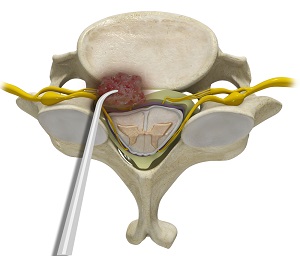
What is Tumor Decompression?
In medicine, decompression is a surgical procedure involving the excision or repositioning of a structure compressing any other structure in your body in order to relieve the pressure.
Spinal decompression refers to various procedures intended to relieve painful pressure on the spinal cord and/or nerve roots caused by compression from another structure.
Tumor decompression is a technique to relieve the pressure in your spine caused by the growth of cancer cells. This involves either partial or complete removal of the tumor.
Indications
Swelling around the spinal cord and back pain due to increased pressure on the spinal cord and nerves are common signs that the procedure is required.
Other indications can be:
- Uncontrollable back pain that radiates to your lower back, buttocks and legs
- Compression of the spinal cord and spinal instability
- Numbness or “pins and needles” over the buttocks or in the toes
- Weakness or tingling in the legs while standing or walking
- A feeling of unsteadiness in the feet or legs and difficulty walking
- Constipation, problems controlling the bowels or loss of bladder control
Preparation
Your surgeon will advise you to take the following pre-surgery steps:
- Stop non-essential medications or herbal remedies
- Reduce or adjust the dosages of essential medications
- Avoid or stop smoking a few days before the surgery
- Fast for a specific period (ideally 6 hours) before the procedure
Procedure
Tumour decompression is performed under general or local anesthesia using one of the following methods:
Vertebroplasty
This is a minimally invasive procedure in which bone cement is injected into a fractured or weakened vertebra to repair and strengthen it.
During vertebroplasty:
- A small incision is made in your back and a radio wave is guided to the tumor location. Radio wave energy helps to break the tumor's cellular molecular bonds.
- The tumor and surrounding tissue are removed. This creates a cavity where the tumor existed.
- A needle is then inserted and guided into the cavity.
- Surgical bone cement or a glue called PMMA is injected into the cavity.
- The needle is removed and the incision is closed with sutures and covered with a bandage.
Vertebroplasty reduces pain, stabilizes the bones, prevents further collapse of the vertebrae, and restores the patient's mobility.
Kyphoplasty
Kyphoplasty is the same as vertebroplasty, except for the following:
- A balloon device is inserted into the incision with the help of a tube and guided to the cavity created after the removal of the tumor.
- The balloon is inflated to expand the cavity. Bone cement or PMMA glue is injected into the cavity.
- The balloon device and needle are taken out, the incision is closed with sutures and the area is covered with a bandage.
Laminectomy
Laminectomy involves the removal of a part of the vertebral bone in your spine called the lamina. This allows your doctor better access to the tumor.
During laminectomy:
- An incision is made at the point where it is easiest to reach the tumor. This might be on your back or your side.
- The tumor along with the lamina is removed using special instruments, and two or more bones at the spot are then connected to stabilize the spine.
- The incision is closed with stitches or surgical staples and covered with a dressing or sterile bandage.
The procedure helps to ease pressure on the spinal cord or the nerve roots caused by the tumors.
Debulking
Debulking is the partial removal of a tumor. Here, as much of the tumor as possible is surgically removed. Chemotherapy is then used, where powerful chemicals are used to kill cancer cells.
Embolization
Embolization is a minimally invasive surgical treatment that causes the tumor to shrink by blocking the blood flow to the tumor.
During embolization:
- A catheter (thin, flexible tube) is guided through a large artery in your thigh to the artery supplying the tumor.
- An embolizing or a glue-like material is then injected into the artery to block blood flow to the tumor.
Your doctor will choose the most appropriate procedure based upon the tumor type, your health status and age, and the likely benefits, risks or complications.
Risks of Tumor Decompression
- Bleeding, blood clots or infection
- Nerve or tissue damage
- Temporary loss of sensation
- Post-operative pneumonia
- Spinal cord injury and/or paralysis
- Allergic reaction to anesthesia
Post-operative Care
As you recover, your doctor will advise you to:
- Place ice packs at the incision site
- Strictly follow the rehabilitation regimen
- Avoid strenuous exertion, such as heavy lifting, for a few weeks
- Gradually increase activity levels
Benefits
Tumor decompression ensures:
- Reduced or no further compression
- Reduced pain and increased mobility
- Stable spine
- Improved function and quality of life





